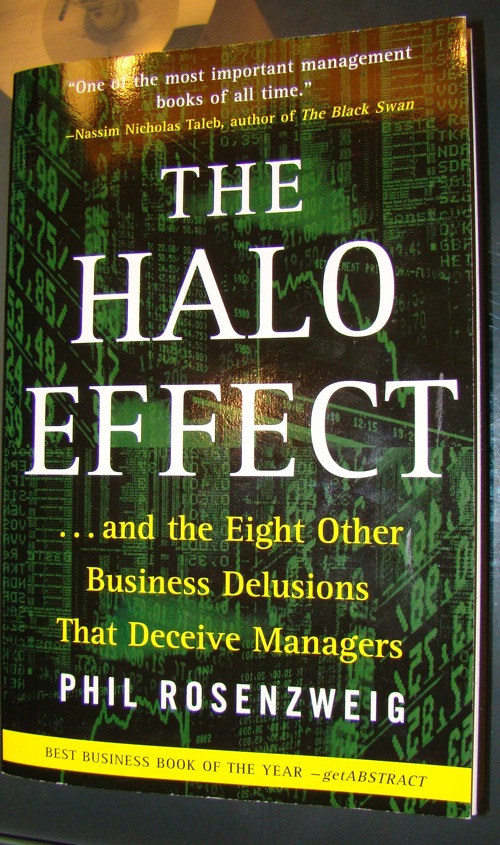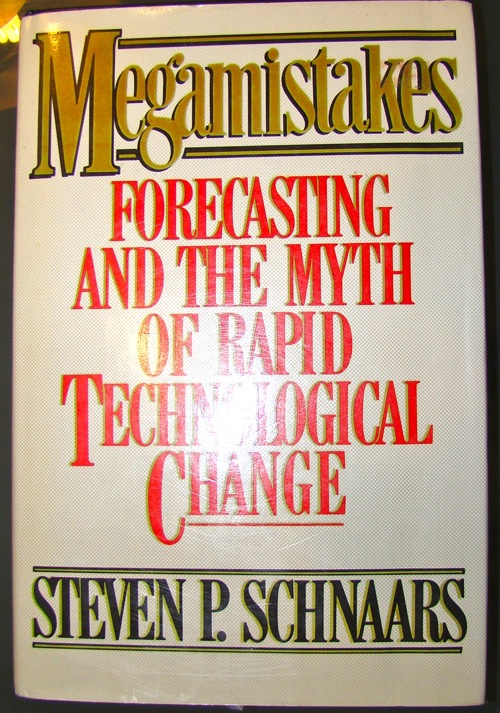The Halo Effect talks about business (research) fallacies. The book is extremely insightful and if you like to learn more about fallacies in business, this book is the right for you.
The book starts to talk about management failures and especially practicing core competencies. Often the definition of a core competence is rather fuzzy it isn’t clear where they begin and end. However, in retrospective it can be rather easily defined as “core competence is where success was” – this fallacy can easily lead to decisions which are more motivated by randomness than by action.
A rather interesting observation is that baseball managers, industry analyst, etc. often say that you need to be both: e.g. be innovate and be conservative – saying this is like saying nothing. It doesn’t matter. And it isn’t the only problem. People don’t like randomness – however, a lot of things are influenced by randomness. One prominent example are stock market movements.
Rosenzweig attributes success of companies, like Wal-Mart, in their scientific rigor which doesn’t longer depends on gut feeling and more on data. Wal-Mart was among the first retailers that studyed pattern in consumption and actually applied that knowledge to their operations. The same methodology is used by successful internet companies, like amazon or eBay.
There were some studies in the military where generals rated soldiers subjectively – often they looked if the men where handsome, had a good posture or polished their shoes nicely. However, these weren’t indicators for being a superior soldiers. It was just the Halo effect: thinking that being good in one thing means that you are great in an other (Thorndike). The same fallacy was told in Moneyball.
Once people — whether outside observers or participants — believe the outcome is good, they tend to make positive attributions about the decision process; and when they believe the outcome is poor, they tend to make negative attributes. Why? Because it’s hard to know in objective terms exactly what constitutes good communication or optimal cohesion or appropriate role clarity, so people tend to make attributions based on other data they believe are reliable.
- Wide variety of behaviors can lead to good decisions => no “optimal” way
- James Meindl (leadership scholar) found that there’s no satisfactory theory of effective leadership that is independent of performance
- The Halo Effect is not inevitable => blind interviews, standardized tests
- Often proxies instead of the real data – be careful
- Validity only if you don’t try to measure performance directly
- Don’t ask “Do you have good leadership?”
- Or “Do you think this is a great place to work?”
- Also: longitudinal Design – better data, but more time consuming
One recent study, by Benjamin Schneider and colleagues at the University of Maryland, used a longitudinal design to example the question of employee satisfaction and company performance to try to find out which one causes which. […] Financial performance, measured by return on assets and earnings per share, has a more powerful effect on employee satisfaction than the reverse.
- Problem: single explanation for performance – assumption: no intercorrelation
Anita McGahan at Boston University and Michael Porter at HBS set out to determine how much of a business unit’s profits can be explained by the industry in which it competes, by the corporation it belongs to, and by the way it is managed. This last category, which they called “segment-specific effects,” covers just about everything we’ve talked about in this chapter: a company’s customer orientation, its culture, its human resource systems, social responsibility, and so forth. […] McGahan and Porter found that “segment-specific effects” explained about 32 percent of a business unit’s performance. The rest was due to industry effects or corporate effects or was simply unexplained.
- Industry and strategy most important
- Long-term out-performance is very unlikely
Delusion of Connecting the Winning Dots:
Peters and Waterman studied a sample made up entirely of outstanding companies. The scientific term for this is sample selection based on the dependent variable — that is, based on outcomes. It’s a classic error.
Foster and Kaplan wrote: “The last several decades we have celebrated big corporate survivors, praising their ‘excellence’, their longevity, their ability to last.” But companies that last longest usually aren’t the best performers. Enduring greatness is neither very likely, nor, when we find it, does it tend to be associated with high performance.
- High profits decline thanks to imitation
- Delusion of Absolute Performance: Company performance is always interdependent on other companies
- Long-term planning doesn’t work. Flexible views are more successful
- The Delusion of Organizational Physics: There’s a underlying theme in management
- Tom Peters, Bobwaterman, Jim Collins and Jerry Porras are great storytellers
- Assumption: There’s an underlying story / meaning in everything in business => Fallacy
- “We have just to do X and we will be rich and famous”
- Strategic choices are very important but risky
- There is luck involved in everything
- If the data is full of Halos, further analysis is futile
- Long success is often based on selection after the fact
- Strategy involves risk – there is no foolproof strategy
- Chances play often greater roles than we like to think
- Avoid the halo effect
- Strategy is more important than operational excellence
- There is randomness
Add together these three factors – uncertain customer demand, unpredictable competitors, and changing technology – and it becomes clear why strategic choice is inherently risky.
Successful companies aren’t “just lucky” – high performance is not purely random – but good fortune does play a role, and sometimes a pivotal one.
I utterly enjoyed The Halo Effect – it is full of business research and shows how it fails or can fail. The three most important lessons are probably:
It was a bit long but insightful. I would recommend the book to everybody who is interested in business research or is active in management or as a consultant. Recommendation!




